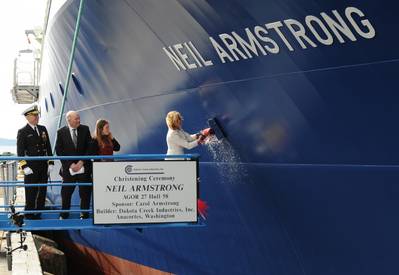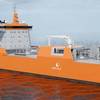US Navy Adds New Research Vessel
Yesterday marked the christening of the U.S. Navy’s new state-of-the-art Auxiliary General Oceanographic Research (AGOR) scientific research vessel R/V Neil Armstrong (AGOR 27) at the Dakota Creek Industries shipyard in Anacortes, Washington.
According to the Office of Naval Research (ONR), the newest research vessel will join its six-vessel research fleet next year. Each vesselis assigned to a U.S. oceanographic institution or university, and is operated by a 20-person university crew (up to 24 scientists can be accommodated on Neil Armstrong for research missions lasting up to a month). Assigned to the Woods Hole Oceanographic Institution, R/V Neil Armstrong will replace R/V Knorr, which is being retired after 45 years of global research, making numerous ocean discoveries, including finding the wreckage of the Titanic.
TIm Schnoor, oceanographic facilities program manager at the Office of Naval Research, said, “Because naval forces operate below, upon and above the seas, understanding the ocean environment is critical to successful operations and keeping Sailors and Marines safe. Enter the research fleet.”
ONR partners with several other federal research partners, such as the National Science Foundation and National Oceanic and Atmospheric Administration, to support and maintain research vessels that include the historic deep-submergence vehicle Alvin, and the Floating Instrument Platform, or FLIP and more, Schnoor explained. U.S.-sponsored oceangoing scientists pursue their global quest every day for new knowledge of the oceans.
“These vessels regularly operate far from their U.S. homeports for months and even years at a time. Replenishment, maintenance and voyage repairs take place in foreign ports, both large and small,” Schnoor said. “Planning for the logistics of scientific research cruises takes place years in advance, and requires constant communication between the ship, crew, science teams and home institutions. International cooperation in ocean science research is a frequent occurrence, and assists the U.S. in achieving science objectives.”
Schnoor highlighted some of the new vessel’s impressive specs:
- 238 feet in length, beam 50 feet
- Cruise speeds of up to 12 knots with a range 11,500 nautical miles
- Mission durations of up to 40 days
- Advanced sonar technology to map the deep, and monitor currents to better understand ocean and atmosphere interaction
- Hull designed to reduce bubble sweepdown from the sonar area, and to enhance the performance of its acoustic sensors
- Propulsion provided by four diesel generators that produce 1044 kW each
- Advanced over-the-side sampling equipment handling systems enable safe work conditions in high seas states
- Deep sea winches and marine cranes support unmanned systems, including remotely operated vehicles autonomous underwater vehicles and unmanned aerial vehicles
The Oceanographer of the Navy, naval meteorologists and the National Hurricane Center benefit from data collected aboard these ships, and from many ocean sensors they moored at sea. This knowledge helps make accurate daily weather predictions and improve computer forecasting models. More than 25 operational prediction systems are actively used by Navy oceanographers that range from global weather to local riverine currents.
A new atmospheric model for tropical cyclones recently went operational for the Navy, Schnoor said. “It works so well, in fact, that the National Hurricane Center credited it as the most significant advance in cyclone intensity prediction in 30 years.”
Schnoor continued, “New research will help us better understand and predict the impacts of the changing Arctic, the creatures inhabiting the oceans, and the safety of mariners who travel its vast surface.”
“I have high expectations for the Armstrong, not just for its design and unique attributes, but for the spirit of discovery its namesake will bring to its mission and crew. Neil Armstrong’s famous words when stepping onto the moon—“This is one small step for man, one giant leap for mankind”—will guide this ship’s work: It is one ship of many in our Navy, but its impact is for all humankind.”











